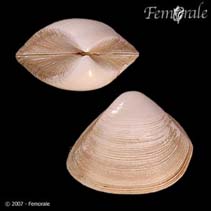Spisula subtruncata (da Costa, 1778)
Subtruncate surf clam
Classification / Names ชื่อสามัญ | ชื่อพ้อง | CoL | ITIS | WoRMS
Bivalvia | Venerida | Mactridae
Environment: milieu / climate zone / ระดับความลึก / distribution range นิเวศวิทยา
; กร่อย; ระดับความลึก 0 - 25 m (อ้างอิง 2758). Subtropical; 71°N - 30°N, 10°W - 36°E
Distribution ประเทศต่างๆ | พื้นที่จำแนกตาม FAO | ระบบนิเวศหลายระบบ | การปรากฏขึ้น,การเกิดขึ้น,พบ | การแนะนำ
Eastern Atlantic and the Mediterranean.
Length at first maturity / ขนาด / Weight / Age
วัยเจริญพันธุ์: Lm ? range ? - ? cm Max length : 3.0 cm SHL เพศผู้/กระเทย; (อ้างอิง 7882)
Depth based on occurrence (Ref. 2758, p. 805); to be replaced with better reference. Species' maximum length from the Belgian part of the North Sea (Ref. 7882). Found in subtidal environment in coastal areas of Europe (Ref. 80598). Lives in shallow soft bottoms (Ref. 80581); in varied sediment types: from fine to coarse sand and mud (Ref. 7882). An active suspension feeder (Ref. 96376).
Life cycle and mating behavior วัยเจริญพันธุ์ | การสืบพันธุ์ | การวางไข่ | Eggs | ความดกของไข่ | Larvae
Members of the class Bivalvia are mostly gonochoric, some are protandric hermaphrodites. Life cycle: Embryos develop into free-swimming trocophore larvae, succeeded by the bivalve veliger, resembling a miniature clam.
Main reference
อ้างอิง | ผู้ประสานงาน | ผู้ร่วมมือ
Gaspar, M.B., M.N. Santos and P. Vasconcelos. 2001. (อ้างอิง 2758)
IUCN Red List Status
(อ้างอิง 130435: Version 2024-2)
CITES status (อ้างอิง 108899)
Not Evaluated
CMS (อ้างอิง 116361)
Not Evaluated
Threat to humans
Human uses
| FishSource |
เครื่องมือ
ข้อมูลเพิ่มเติม
นิเวศวิทยาเขตร้อน
นิเวศวิทยา
Population dynamics
การเจริญเติบโต
Max. ages / sizes
Length-weight rel.
Length-length rel.
Length-frequencies
Mass conversion
การทดแทนที่
อุดมสมบรูณ์
Max. ages / sizes
Length-weight rel.
Length-length rel.
Length-frequencies
Mass conversion
การทดแทนที่
อุดมสมบรูณ์
Life cycle
Distribution
Human Related
Aquaculture profiles
Stamps, coins, misc.
Stamps, coins, misc.
Outreach
Taxonomy
อ้างอิง
แหล่งที่มาจากอินเตอร์เน็ต
BHL | BOLD Systems | CISTI | DiscoverLife | FAO(Publication : search) | Fishipedia | GenBank (genome, nucleotide) | GloBI | Gomexsi | Google Books | Google Scholar | Google | PubMed | แผนภูมิชีวิตแบบต้นไม้ | Wikipedia (Go, ค้นหา) | บันทึกทางด้านสัตววิทยา



